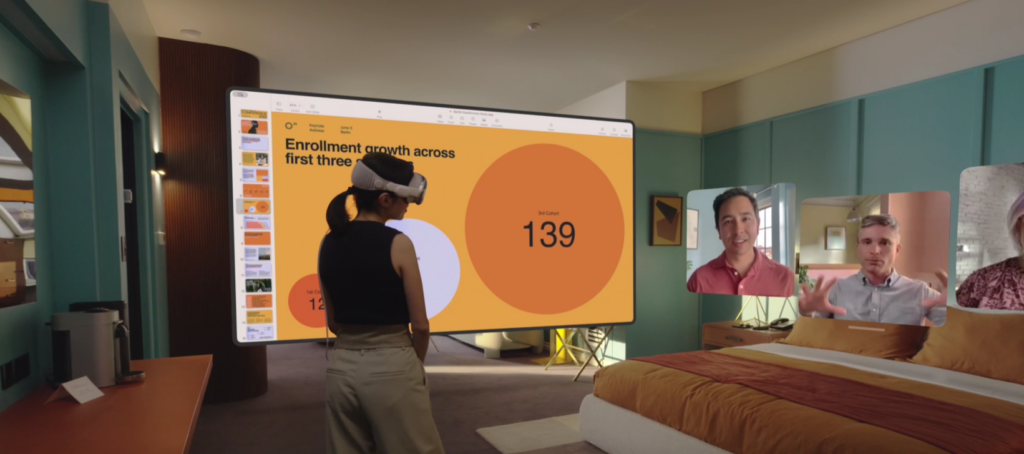Image credit: Apple
Prepare to be captivated by the awe-inspiring world of spatial computing. Apple’s ground-breaking announcement of the Apple Vision Pro at this year’s WWDC has sent shockwaves through the tech industry. Dubbed a “spatial computer,” this cutting-edge headset seamlessly merges the realms of the physical and the digital, granting users unparalleled capabilities. Imagine stepping into an augmented workspace where peripherals fade away, environments transform at will, and collaborating on presentations becomes a captivating, face-to-face experience through the Facetime app. And this is just the beginning, for Apple plans to release the Vision Pro in early 2024, allowing developers ample time to create an array of third-party apps that will further expand the headset’s capabilities.
In the wake of Meta’s staggering $10 billion misstep with the Metaverse last year, could Apple be the herald of a new era, taking extended reality (XR) – encompassing augmented, virtual, and mixed reality – to the mainstream? Is augmentation the path to the future, rather than replacing the physical world altogether? Most importantly, how can this ground-breaking technology reshape the way we work?
The Impact of Spatial Computing on the Workplace: Collaborative Transformation
Prepare for a potentially seismic shift in the way we work, both within and beyond office walls. Spatial computing holds the potential to revolutionise collaboration, turbocharge productivity, enhance well-being, and even promote sustainability. Let us explore the profound impacts this technology can bring:
Redefining Remote Collaboration: Spatial computing empowers us to collaborate with newfound ease, regardless of physical distance. In industries requiring specialised training, employees can immerse themselves in virtual environments that mirror their real-world work settings, engaging in simulated scenarios for more effective learning. Moreover, imagine transcending the limitations of video calls, as spatial computing virtually transports individuals from across the globe, enabling them to collaborate in a manner that feels more authentic and human. With location and geography ceasing to be obstacles, this technology can connect us like never before.
The Perfect Work Environment: With the ability to shape our virtual surroundings, spatial computing empowers users to craft their ideal work environment, propelling productivity to new heights. By banishing distractions and curating personalised settings that foster concentration, individuals can reach their full potential. Furthermore, this technology nurtures problem-solving and facilitates learning through interactive tutorials and guides, paving the way for intuitive and immersive education.
Liberating Creativity: Unleashed from the constraints of conventional monitors, spatial computing opens up a limitless canvas for creativity. Working with an infinite interface and employing our voice, hands, and eyes to control this computer, we enter an era of intuitive and fluid work dynamics. Prepare to witness an outpouring of imaginative endeavours.
Conclusion: The Dawn of a Spatial Computing Revolution
Spatial computing could reshape the modern workplace, ushering in a new era of collaboration, well-being, productivity, and creativity. However, while the Vision Pro’s release is slated for next year, mass adoption may still lie further on the horizon. Therefore, waiting for this technology to drive improvements in these critical aspects of business would be ill-advised. Instead, organisations should actively seek to drive cultural change by assessing and nurturing their existing culture, striving to create the environment they need to flourish.
As we stand at the precipice of a new frontier, where spatial computing has the potential to become an integral part of our lives, we cannot help but wonder: Could this technology truly shape the future? Or is it reminiscent of the “Ready Player One” universe, destined to remain in the world of fiction?
Culture15 is your complete toolkit for tracking culture change. CEOs and Exec Teams at world-leading organisations use Culture15 analytics to ensure success by aligning their culture with what they need to execute their strategy. If you’d like to find out how to define the culture and values you need, diagnose the culture you have and close the gap, talk to our team.



